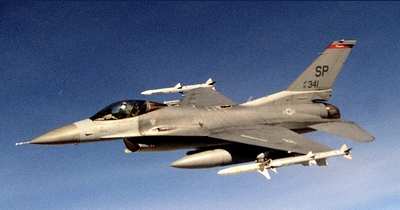Sun, Dec 05, 2010
Demonstration Flights For Raytheon System Flown By USAF,
Lockheed Martin
An Advanced Combat Radar, the latest Active Electronically
Scanned Array radar developed by Raytheon Company has successfully
completed a series of flight trials on a U.S. Air Force F-16 at
Edwards Air Force Base, CA. The radar demonstration flights were
conducted in partnership with the U.S. Air Force and Lockheed
Martin. The RACR team highlighted the multirole capabilities RACR
could bring to the F-16 Fighting Falcon, which included executing a
range of air-to-air and air-to-ground modes.

F-16 File Photo
RACR is the product of company-funded development, leveraging
Raytheon's proven capability in providing active electronically
scanned array radar technology for multiple platforms. The RACR
team completed development in a record 24 months. "AESA radar
technology has become a 'must have' for customers around the world
who need to keep their aircraft relevant in the swiftly evolving
battlespace," said Jim Hvizd, vice president, international
business development, Raytheon Space and Airborne Systems.
"Successfully flying RACR on an F-16 is another critical step in
demonstrating how we've optimized our AESA technology for F-16
customers, delivering the advanced radar capabilities they need to
maintain an operational edge.

"Raytheon's AESA technology also lowers operation and support
costs by an order of magnitude compared with those of mechanically
scanned radars, resulting in significant customer savings over the
life of a program," added Hvizd.
RACR is part of a family of Raytheon AESA radar systems designed
to equip multiple aircraft with a low-risk, high-performance,
affordable solution. The radar supports a rapid transition to
production, leveraging Raytheon's existing full-rate AESA
production lines, providing significant cost and schedule
advantages for customers.
"Raytheon's AESA technology brings unparalleled capability and
reliability to the F-16 at an acquisition cost comparable to the
old mechanically scanned radars," said Brian MacDonald, RACR
program manager, Raytheon's Tactical Airborne Systems. "RACR
is now available as an option for domestic and international
customers. We have designed, built and matured RACR from concept
through to F-16 flight demonstration to ensure we can support any
customer delivery time frames for new or retrofit aircraft
requirements."
More News
Decision Altitude (DA) A specified altitude (mean sea level (MSL)) on an instrument approach procedure (ILS, GLS, vertically guided RNAV) at which the pilot must decide whether to >[...]
Aero Linx: T-34 Association, Inc. The T-34 Association was formed in July 1975 so that individuals purchasing then military surplus T-34As had an organization which would provide s>[...]
As He Released The Brakes To Begin Taxiing, The Brake Pedals Went To The Floor With No Braking Action Analysis: The pilot reported that during engine start up, he applied the brake>[...]
“Legislation like the Mental Health in Aviation Act is still imperative to hold the FAA accountable for the changes they clearly acknowledge need to be made... We cannot wait>[...]
Also: IAE Acquires Diamond Trainers, Army Drones, FedEx Pilots Warning, DA62 MPP To Dresden Tech Uni The danger to the flight training industry and our future pilots is clear. Dona>[...]
 ANN's Daily Aero-Term (12.08.25): Decision Altitude (DA)
ANN's Daily Aero-Term (12.08.25): Decision Altitude (DA) ANN's Daily Aero-Linx (12.08.25)
ANN's Daily Aero-Linx (12.08.25) NTSB Final Report: Piper PA-31T3
NTSB Final Report: Piper PA-31T3 Aero-News: Quote of the Day (12.08.25)
Aero-News: Quote of the Day (12.08.25) Airborne-Flight Training 12.04.25: Ldg Fee Danger, Av Mental Health, PC-7 MKX
Airborne-Flight Training 12.04.25: Ldg Fee Danger, Av Mental Health, PC-7 MKX




